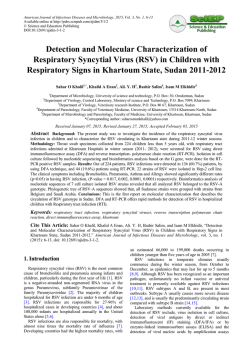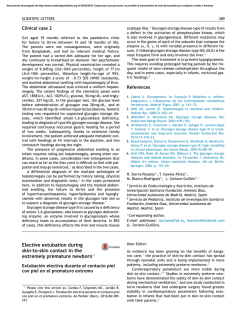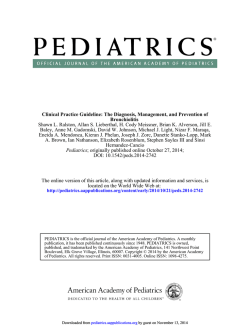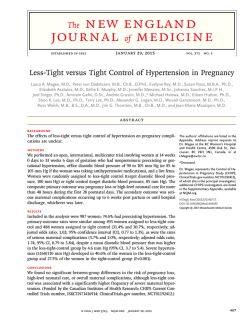
Efectividad, seguridad y eficiencia del palivizumab en la prevencion
CONSEJERÍA DE IGUALDAD, SALUD Y POLÍTICAS SOCIALES AGENCIA DE EVALUACIÓN DE TECNOLOGÍAS SANITARIAS DE ANDALUCÍA (AETSA) Efectividad, seguridad y eficiencia del palivizumab en la prevención de la infección por el virus respiratorio sincitial en prematuros Informe de evaluación Effectiveness, safety and efficiency of palivizumab for prevention respiratory syncytial virus infection in premature 2014 INFORME_4 CONSEJERÍA DE IGUALDAD, SALUD Y POLÍTICAS SOCIALES Agencia de Evaluación de Tecnologías Sanitarias de Andalucía (AETSA) Informe de evaluación Efectividad, seguridad y eficiencia del palivizumab en la prevención de la infección por el virus respiratorio sincitial en prematuros Avda. de la Innovación s/n. Edificio ARENA 1. Planta baja CONSEJERÍA DE IGUALDAD, SALUD Y POLÍTICAS SOCIALES 41020 Sevilla - España (Spain) Tlf.: +34 955 006 309 - Fax: +34 955 006 327 e-mail: [email protected] Sevilla, julio de 2014 2014 INFORME_4 Efectividad, seguridad y eficiencia del palivizumab en la prevención de la infección por el virus respiratorio sincitial en prematuros Raúl García-Estepa, Carmen Navarro-Palenzuela, Javier Bautista-Paloma, Antonio Romero-Tabares, Carmen Beltrán-Calvo Agencia de Evaluación de Tecnologías Sanitarias de Andalucía CONSEJERÍA DE IGUALDAD, SALUD Y POLÍTICAS SOCIALES JUNTA DE ANDALUCIA García-Estepa, Raúl Efectividad, seguridad y eficiencia del palivizumab en la prevención de la infección por el virus respiratorio sincitial en prematuros. Raúl García-Estepa, Carmen Navarro-Palenzuela, Javier Bautista-Paloma, Antonio Romero-Tabares, Carmen Beltrán-Calvo. ―Sevilla: Agencia de Evaluación de Tecnologías Sanitarias, 2014. 89 p. 21 x 29,7 cm ISBN 978-84-15600-63-3 1. Infecciones por virus sincitial respiratorio / prevención y control 2. Anticuerpos monoclonales / uso terapéutico 3. Prematuro I. Navarro-Palenzuela, Carmen II. Bautista-Paloma Javier III. Romero-Tabares, Antonio IV. Beltrán-Calvo, Carmen V. Andalucía. Agencia de Evaluación de Tecnologías Sanitarias. Edita: Agencia de Evaluación de Tecnologías Sanitarias de Andalucía www.juntadeandalucia.es/salud/aetsa [email protected] Avda. de la Innovación. Edificio Arena 1, planta baja. 41020 Sevilla España – Spain ISBN: 978-84-15600-63-3 Cita sugerida: García-Estepa R, Navarro-Palenzuela C, Bautista-Paloma J, Romero-Tabares A, Beltrán-Calvo C. Efectividad, seguridad y eficiencia del palivizumab en la prevención de la infección por el virus respiratorio sincitial en prematuros. Sevilla: Agencia de Evaluación de Tecnologías Sanitarias de Andalucía; 2014. Autoría y colaboraciones Grupo elaborador Miembros del equipo evaluador de la Agencia de Evaluación de Tecnologías Sanitarias de Andalucía (AETSA) Raúl García-Estepa. Doctor en Farmacia. Servicio de Evaluación de Tecnologías Sanitarias. (AETSA). Planteamiento de las preguntas de investigación, metodología, búsqueda bibliográfica, selección de estudios, valoración de la calidad metodológica, extracción de datos y síntesis de los resultados, discusión y conclusiones de efectividad y seguridad. Contribución al análisis económico. Revisión de la eficiencia. Carmen Navarro-Palenzuela. Técnico en Economía de la Salud. (AETSA). Planteamiento de las preguntas de investigación, metodología, búsqueda bibliográfica, selección de estudios, valoración de la calidad metodológica, extracción de datos y síntesis de los resultados, discusión y conclusiones de eficiencia. Elaboración del análisis económico. Revisión de la efectividad y seguridad. Javier Bautista-Paloma. Especialista en Farmacia Hospitalaria. Director de la Unidad de Gestión Clínica de Farmacia del Hospital Universitario Virgen del Rocío (Sevilla). Planteamiento de las preguntas de investigación, aportación de datos para la elaboración de la evaluación económica propia y revisión del informe final. Antonio Romero-Tabares. Doctor en Medicina. Jefe de Servicio de Documentación e Información (AETSA). Búsqueda bibliográfica y revisión del informe final. Carmen Beltrán-Calvo. Jefa de Servicio de Evaluación de Tecnologías Sanitarias (AETSA). Planteamiento de las preguntas de investigación, coordinación técnica y revisión del informe final. Conflicto de interés Los autores declaran que no tienen intereses que puedan competir con el interés primario y los objetivos de este informe e influir en su juicio profesional al respecto. AETSA 2014 / Palivizumab en prematuros Executive summary Background and justification RSV causes acute upper respiratory tract infection in patients with different ages and it is one of the most common diseases of childhood. It affects approximately 75 % of children during the first year of life and almost 90 % at the end of the second year. RSV infection may present a wide range of severity, from mild respiratory symptoms such as rhinitis or otitis media, to bronchiolitis, tracheobronchiolitis and pneumonia with significant morbidity that may increase the risk of death. RSV is the causative agent of 60-90 % of bronchiolitis. RSV infection shows a marked seasonal prevalence with the highest incidence in the winter months. The premature babies were born at 35 weeks gestational age or less is a risk group where infection often progresses to a serious illness. Important national and international organizations have developed, reviewed and updated recommendations for use of palivizumab in order to improve the efficiency of health systems. However, differences were detected between the recommendations made by these organizations for the administration of palivizumab as prophylaxis of RSV infections in premature infants. As a result, the Direction of Andalusian Public Health System through the Division of Pharmacy Services requested to the Direction of the Andalusian Agency for Health Technology Assessment (AETSA) preparing this report to collect the best information available in the scientific literature and thus clarify the discrepancies found between the various recommendations. Objective The objective of this report is to identify the available evidence on effectiveness, safety and efficiency of the administration of palivizumab as prophylaxis of RSV infections in premature infants and through a own economic evaluation, estimate their efficiency in the context of Andalusian Public Health System. This report attempts to answer the following research questions: 1. Is administration of palivizumab to prevention of RSV infection in premature infants 6-12 months of age at the start of the RSV season with less than 29 weeks gestational age effective, safe and efficient? 2. Administration of palivizumab in premature infants of 32-35 weeks gestational age with risk factors: 2a. Is administration of palivizumab to prevention of RSV infection in premature infants of 32-35 weeks gestational age and 2 major risk factors (chronological age less than 10 weeks at the beginning of the RSV season or born in the first 10 weeks of it, have at least one brother in school-age or attends child care or go to child care) effective, safe and efficient? 2b. Is administration of palivizumab to prevention of RSV infection in premature infants of 32-35 weeks gestational age with 1 major and 2 minor risk factors (history of maternal smoking during pregnancy and male sex) effective, safe and efficient? < 17 > AETSA 2014 / Palivizumab en prematuros Methodology A systematic review of the literature was carried out on the effectiveness, safety and efficiency of palivizumab to prevention of RSV infection in premature infants. For this purpose, the reference databases MEDLINE (Ovid and Pubmed) and EMBASE were consulted up to March 2014. This search was completed with searches in the SCI, CRD and PEDE databases. A critical reading of the selected articles was made to identify the methodological problems that could affect the internal validity of the studies. Finally, the extraction and summary of the described results in each selected study was made. Finally, a own economic evaluation was made. It consisting of a cost-utility analysis, expressed as cost per QALY, and a cost-effectiveness analysis, expressed in cost per LYG. This economic evaluation was made through a decision model of one year from the perspective of the Andalusian Public Health System in preterm infants of 32-35 weeks gestational age with two major risk factors or one major and two minor factors. Sensitivity and probabilistic analyses were also conducted. Another cost-effectiveness analysis was made, expressed in cost per avoided hospitalization, obtaining the budget impact of prophylaxis with palivizumab in the target population in Andalucía. Results A cohort study with some methodological limitations that responds to effectiveness in preterm of 32-35 weeks gestational age with risk factors (two major risk factors, 1 major risk factor and 2 children) (question 2a and 2b) has been located. However, it has not located any studies that evaluate the effectiveness of the administration of palivizumab in preterm infants less than 29 weeks gestational age and 6-12 months of age at the start of the RSV season (question 1). Moreover, no study that assesses the safety of palivizumab in the target population of the report has been localized. In terms of efficiency, three cost-utility studies have been located, one of them answered question 1, three responded to the question 2a and none to the question 2b. In terms of effectiveness, the results of the study showed that administration of palivizumab significantly decreased the probability of hospitalization for RSV infections in premature infants of 32-35 weeks gestational age (with 2 major risk factors, 1 major and 2 minor risk factors) with relative risk values of 0.28 and 0.26, respectively, reducing the risk of hospitalization by more than 70% in both cases. Regarding the number of patients needed to treat, in group with 2 major risk factors would need to treat 13,5 children to avoid a hospitalization for RSV infection, whereas in group with 1 major + 2 minor risk factors would require to treat 15,1 infants. In terms of efficiency, the incremental cost-utility ratios (ICUR) from the localized study to preterm infants < 29 weeks gestational with 6-12 months of age at the start of RSV season were very high. The most favorable case, in premature infants less than 24 weeks gestational age and 6-9 months of age at the start of the RSV season, the ICUR stood at more than £300,000/QALY. In the case of premature infants of 32-35 weeks gestational age with 2 major risk factors, the results of the 3 identified studies provided very conflicting results, ICUR ranging from outright inefficiency (more than £200,000/QALY) to a very high efficiency (16,037 USD/QALY) through an medium efficiency (44,774 USD/QALY). The own economic evaluation, for the target population (32-35 weeks gestational age), obtained a ICUR of €867,994.63/QALY. Furthermore, the results of deterministic sensitivity analysis confirmed that, in any scenario, palivizumab was an inefficient strategy. The probabilistic sensitivity analysis, performed through a Monte Carlo model with 1,000 simulations, showed that < 18 > AETSA 2014 / Palivizumab en prematuros considering a threshold of €30,000/QALY, palivizumab was efficient in 0.0027 % of the cases. If we increase the willingness to pay €100,000/QALY, palivizumab would be efficient in only 11 % of cases. Finally, the cost per avoided hospitalization was €40,744.42 and 69 hospitalizations would be avoided to a differential cost (budget impact) of €2,811,365.04 per year. Conclusions 1. The localized evidence to study the effectiveness, safety and efficiency of palivizumab in the subgroups of preterm infants target has been poor. 2. More and higher quality studies are needed to recommend with high grade the palivizumab administration in infants less than 29 weeks gestational age with 6-12 months of age at the start of the RSV season and infants of 32-35 weeks gestational age with risk factors (two major risk factors; 1 major and 2 minor risk factors). Effectiveness and safety 3. Specific safety information about the target population of report has not been localized. Question 1 (< 29 weeks gestational age, 6-12 months of age at the start of the RSV season) 4. There is no scientific evidence to support the administration of palivizumab in premature infants less than 29 weeks gestational age with 6-12 months of age at the start of the RSV season to prevent RSV infection. Question 2a y 2 b (32-35 weeks gestational age with risk factors) 5. There is weak scientific evidence supporting the effectiveness of palivizumab in preterm infants of 32-35 weeks gestational age with risk factors (two major risk factors, 1 major and 2 minor risk factors), in terms of reduction of hospitalizations. A cohort study with some methodological limitations endorses the recommendation of palivizumab administration. Systematic review of effectiveness 6. The number of risk factors is a key element in determining the efficiency of palivizumab in premature infants without heart or lung disease. The localized evidence suggests that at least two risk factors are needed for further study its efficiency. Question 1 (< 29 weeks gestational age, 6-12 months of age at the start of the RSV season) 7. The efficiency of palivizumab in premature infants less than 29 weeks gestational age and 6-12 months of age at the start of the RSV season, has been studied in a single study that concludes that it is not efficient, with ICUR well above the thresholds commonly accepted. Question 2a y 2 b (32-35 weeks gestational age with risk factors) 8. The efficiency of palivizumab in preterm infants of 32-35 weeks gestational age and two major risk factors has been collected in three studies. The results are very contradictory, so one can not say that prophylaxis is efficient in that case. 9. Scientific evidence about the efficiency of palivizumab in preterm infants of 32-35 weeks gestational age with 1 major and 2 risk factors has not been found. < 19 > AETSA 2014 / Palivizumab en prematuros Own economic evaluation 10. The prophylactic use of palivizumab in preterm infants of 32-35 weeks gestational age with risk factors (two major risk factors; 1 major and 2 minor risk factors) in the context of SSPA can not be considered efficient under normal decision thresholds, with a figure of €867,994/QALY. 11. The deterministic sensitivity analysis carried out confirm that changes in the majority of the model variables, in any prophylaxis scenario with palivizumab is not an efficient strategy. 12. The probabilistic sensitivity analysis confirms that with a willingness to pay €30,000/QALY, palivizumab is not efficient in 99.97 % of cases. 13. The model performed, despite its limitations, is consistent with other previously studies not funded by industry, that support the conclusion number 10. 14. From own cost-effectiveness analysis, the cost per avoided hospitalization was €40,744.42. However, there are not thresholds to considerar if the intervention is or not efficient, in these terms. 15. The budget impact of the administration of palivizumab in this population in Andalusia is above 2.5 millions of euros per year. < 20 >
© Copyright 2025



